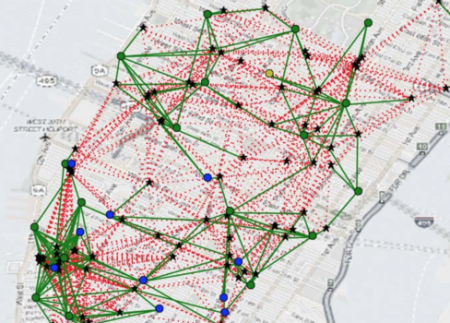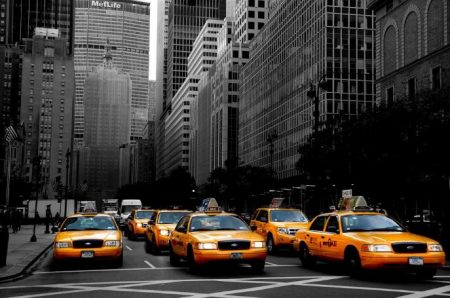January 3, 2017 – The appeal of a world of fewer cars on city streets because of autonomous ride-sharing vehicles is reflected in the latest study by the Computer Science and Artificial Intelligence Lab at Massachusetts Institute of Technology. Of all the cities in the world that I have ever visited it is New York that has always been associated with an endless stream of yellow-painted taxicabs (see image below). There are approximately 13,000 plying its streets today carrying over 1 million passengers and averaging 170 million trips annually. But that could all change with autonomous ride-sharing vehicles.
The MIT team took the estimated 2013 data of weekly 3 million cab rides and applied an algorithm which took ride origins, applied ride-sharing, and came up with a much reduced need for vehicles. It found that with 3,000 autonomous vehicles shared by 2 riders, 94% of New York’s taxi demand could be met. Surprisingly a 10-person ride-sharing vehicle only yielded a coverage improvement of 1%. But with 4 rider car sharing 98% of coverage demand was met. The average wait time for on-demand ride requests using the model was calculated at 2.7 minutes. That compared favorably with Uber and Lyft on demand usage in New York today, in fact 20% less in terms of wait-time delay.
Daniela Rus, lead researcher of the study, and Professor at MIT, stated, “To our knowledge, this is the first time that scientists have been able to experimentally quantify the trade-off between fleet size, capacity, waiting time, travel delay, and operational costs for a range of vehicles, from taxis to vans and shuttles….the system is particularly suited to autonomous cars, since it can continuously reroute vehicles based on real-time requests.”
The positives to this study:
- Significant productivity gains with shorter commute times through a ride-sharing system that leads to less traffic and congestion on New York City streets saving an estimated 5.5 billion hours people today spend sitting in traffic.
- Almost 11 billion liters (2.9 billion gallons) less gasoline and diesel burned.
- Carbon dioxide emission reductions equaling 89.9 billion kilograms (20.5 million tons).
The negatives:
- For most commuters today in New York, a taxicab can be hailed on almost any city street, no wait times at all.
- If implemented it would put most of the 50,000 New York cabbies employed out of work.

















